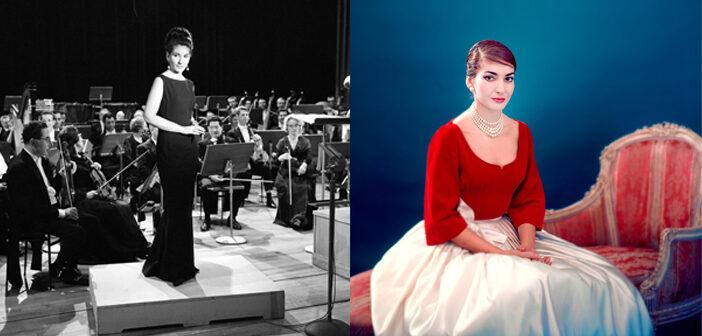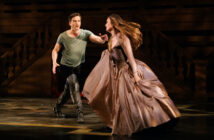
This page is also available in / Cette page est également disponible en:
![]() Francais (French)
Francais (French)
It happens almost everyday. Someone discovers opera for the first time through a live performance, and it becomes life changing. But it’s not everyday that this passion produces insight into the mysterious and iconic life of La Divina Maria Callas.
French filmmaker Tom Volf, whose eclectic background included work as a model and photographer, was a medical student in New York in 2013 when he attended by chance a performance of Donizetti’s Maria Stuarda at the Metropolitan Opera.
“Joyce DiDonato was singing the lead role, and the combination of music, theatrical and cinematic elements was transformative,” he recalls. “I fell in love with opera because of Donizetti and David McVicar, and first and foremost, Joyce.”
After the performance, he searched the Internet and the name Maria Callas kept coming up. “It was the second big revelation. She was exactly the same as what I had discovered in Joyce, singing at the highest level, attention to the composer, matched with acting.”
This led him on a three-year pilgrimage following her footsteps. “I started the journey of making the film by looking for the people close to her.” Volf met over 30 of Callas’s closest friends. The key was to secure the trust of her maid and butler, who had lived with her and whom she considered family. Others soon were willing participants.
The documentary Maria by Callas features never-before-seen letters, films, photographs and other documents that allow Maria – and Callas – to tell the story in their own words, including footage from a 1970 interview with David Frost when Maria was the most candid. Thought forever lost, luckily, her butler had filmed it in Super 8 and recorded the sound on a reel-to-reel tape recorder.
“It’s different from everything else, more of a confession,” says Volf. “The film is almost a flashback on the talk. She appears more Maria than Callas. [The year]1970 was just two years after Onassis and Jackie and right after her movie. She was vulnerable and very honest. Frost had a way to get her out of her comfort zone. They laugh. It was very revealing about her life.”
The documentary traces Callas from childhood in New York to her adolescence in Greece when she was enrolled underaged in the conservatory. Maria’s recollection and interviews with her teacher Elvira de Hidalgo are quite insightful, though this part and her early career, including her weight loss, represent is quite short. “There wasn’t very much footage of available of her early years,” explained Volf. “I want to reach the pinnacle of her career in 1958.”
What sets this documentary apart from pervious dramatizations and books is the access to the letters, which revealed Maria’s personal thoughts. Most revealing is the reason behind her vocal decline from a combination of nerves and her relationship with Onassis.
Volf dismisses a 2010 study by Italian vocal researchers Franco Fussi and Nico Paolillo, who attribute her vocal decline to her weight loss. “People try to look for complicated reasons Things can be quite simple, and she says it herself.
She acquired the stage fright. It came with the scandals and Rome was a major break in her life, career and also her nervous sate.
“I wanted to show why and how Rome happened. She became frightened that something might happen, and that she would not be able to finish an opera, and that she would be lynched for that. Rome created a lot of fear. Once she had reached that level of career, people expected more and more.
“On some nights she was in good voice and others not. First and foremost, it was the expectations from herself. Will my voice obey to my commands? She suffered a lot by that.”
The movie looks at her much-publicized affair with Aristotle Onassis – both before and after his marriage to Jacqueline Kennedy in 1968. The two met in 1957 while they were both still married to others (her social-climbing then-husband arranged the meeting). The film also sheds light on the reasons for her divorce in 1959. We learn through letters and interviews that once in a relationship with Onassis, Maria didn’t feel the need to perform or practice anymore. She wanted instead more a simple life, to fulfill the role of wife and possibly mother.
The most heartbreaking part is when Maria recounts learning about Ari’s marriage to Jackie by reading about it in the newspapers. Still, it was with Ari that Maria found at least some happiness in her life. “He made me feel liberated,” she said. In the end, she took him back into her life. “My affair with Onassis was a failure, but my friendship with him, a success,” she said.
Running almost two hours, the film, according to Volf, had enough material for 40. He worked six months, seven days a week editing the film with filmmaker Janice Jones. He is proud that about 30% to 40% include complete performances of Callas. As a fitting bookend, Volf invited Joyce DiDonato (whom he had befriended by then) to narrate Maria’s letters in the film (in the French version, it’s Fanny Ardant).
Volf, who did finish his medical studies, has created three books as companions to the film, including a picture book and a book of letters and quotations. An exhibition debuted in France last year and will travel to Moscow next year. “I created in Paris the Callas Foundation, and we plan to have a Callas museum in Paris.”
Volf is ever the converted opera fan, especially for bel canto repertoire. “I’m going to premier the film in San Francisco, and Sondra Radvanovsky is singing Roberto Devereux that night. I’m tempted to skip out and hear her sing. She is also part of the legacy of Callas.”
Maria by Callas opens on Oct. 26, 2018 in Montreal (Beaubien, Forum), Quebec City (Le Clap) and Ottawa (ByTowne). Visit mySCENA.org to win one of 10 double passes.
This page is also available in / Cette page est également disponible en:
![]() Francais (French)
Francais (French)














